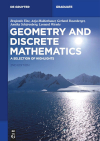- About MAA
- Membership
- MAA Publications
- Periodicals
- Blogs
- MAA Book Series
- MAA Press (an imprint of the AMS)
- MAA Notes
- MAA Reviews
- Mathematical Communication
- Information for Libraries
- Author Resources
- Advertise with MAA
- Meetings
- Competitions
- Programs
- Communities
- MAA Sections
- SIGMAA
- MAA Connect
- Students
- MAA Awards
- Awards Booklets
- Writing Awards
- Teaching Awards
- Service Awards
- Research Awards
- Lecture Awards
- Putnam Competition Individual and Team Winners
- D. E. Shaw Group AMC 8 Awards & Certificates
- Maryam Mirzakhani AMC 10 A Awards & Certificates
- Two Sigma AMC 10 B Awards & Certificates
- Jane Street AMC 12 A Awards & Certificates
- Akamai AMC 12 B Awards & Certificates
- High School Teachers
- News
You are here
Geometry and Discrete Mathematics: A Selection of Highlights

Publisher:
De Gruyter
Publication Date:
2022
Number of Pages:
450
Format:
Paperback
Edition:
2
Series:
De Gruyter Textbook
Price:
59.99
ISBN:
9783110740783
Category:
Textbook
The Basic Library List Committee suggests that undergraduate mathematics libraries consider this book for acquisition.
[Reviewed by , on ]
Tricia Muldoon Brown
11/28/2022
This review is for the second edition of the text. According to the preface, the second edition contains a new chapter on simplicial complexes and topolgical data analysis and moves and extends the graph theory content to its own chapter. The selection of topics is broad; beginning with Euclidean geometry and covering geometry topics such as isometries, Platonic solids, and spherical geometry, but also topics from topology, combinatorics, graph theory, and probability theory.
I like the way the book is written. The math is mixed in with short historical background sentences on the context, development, or author of the results. The authors do a good job of proving results when it makes sense to do so and offering references when the proofs are too long or not really essential to the discussion. It is concise. Like a research paper, the chapters are organized into numbered parts with definitions, theorems, facts, remarks, etc. There are fewer figures than I expected for a book on geometry, but those included seem to be clear and effective.
Another advantage of the brevity is the ability to pack the book full of a wide array of results. For example, the graph theory chapter covers basic terminology, Hasse diagrams, equivalence theorems on trees and spanning tree results, crossing-free (or non-crossing) graphs, Euler’s formula, graph coloring, the marriage theorem and stable marriage problem, Euler lines (paths), and Hamilton lines with the traveling salesman problem and graph algorithms. There is also a capable index at the end when you want to search for a particular topic. (Readers with a typically American education like mine, may notice a difference of terminology at times, as illustrated in the topic list above, but the meaning of the alternate term was always clearly stated and in no way detracts from the book.)
I would probably not use this as the sole text for a class because, as the subtitle says, it is a collection of highlights. I do think it will be useful for parts of a course, as a reference, or for inspiration of project topics. The succinct nature of the writing is also very helpful if you just need to brush up on a topic quickly. Some level of mathematical sophistication is necessary to read the book. While it is generally self-contained, as with any book aimed at a graduate audience, there is an expectation of foundational knowledge in algebra, geometry, and proofs. However, you do not need to be an expert. I believe researchers and students with various backgrounds would enjoy this book.
Tricia Muldoon Brown (tmbrown@georgiasouthern.edu) is a Professor of Mathematics at Georgia Southern University with interests in combinatorics, recreational mathematics, and sports.
See the publisher's website.
- Log in to post comments




